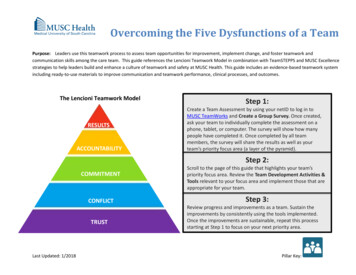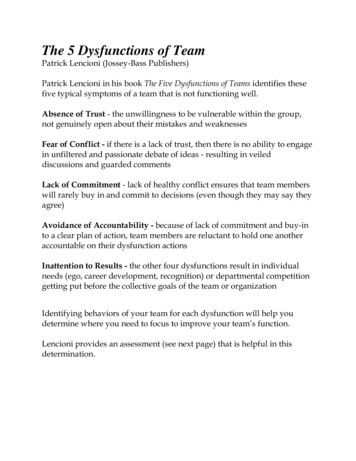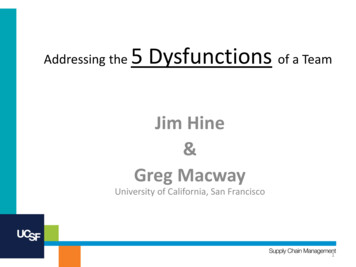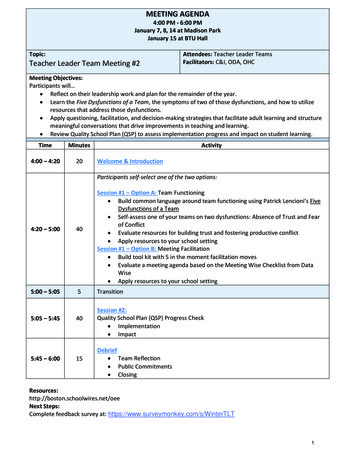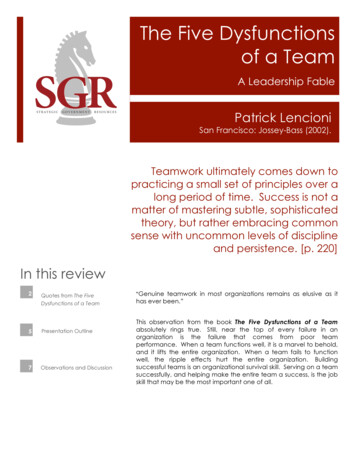
Transcription
TheFiveDysfunctionsof a TeamAssessment ReportA Sample CompanyA Sample TeamMay 27, 2008
team assessment reportIntroductionThe primary purpose of this report is to provide your team with a sense of its strengths and areas forimprovement. While the Assessment itself is certainly quantitative and data-driven, its most importantaspect is the qualitative perspective it provides for your team and the discussion that it provokesaround specific issues.If you have not yet read the book The Five Dysfunctions of a Team, the following pages are includedto give you a summary of the teamwork model that this Assessment is based upon. This will help youinterpret your team’s results.If you are familiar with the Dysfunctions model, you can skip ahead to page 5, and investigate theinterpretations of your scores.Page 2 Copyright 2003 The Table Group, Inc. w 3640 Mt. Diablo Blvd., Suite 202 wLafayette, CA 94549 wwww.tablegroup.com
team assessment reportThe ModelLike it or not, all teams are potentially dysfunctional. This is inevitable because they are made up offallible, imperfect human beings. From the basketball court to the executive suite, politics andconfusion are more the rule than the exception.But the power of teamwork is great. The founder of a billion dollar company best expressed thatpower when he once said, "If you could get all the people in an organization rowing in the samedirection, you could dominate any industry, in any market, against any competition, at any time."Whenever a group of leaders hears this adage, they immediately nod their heads, but in a desperatesort of way. They seem to grasp the truth of it while simultaneously surrendering to the impossibilityof actually making it happen.Fortunately, the causes of dysfunction are both identifiable and curable. However, they don’t dieeasily. Making a team functional and cohesive requires extraordinary levels of courage and discipline.The following section provides an overview of the five behavioral challenges all teams mustcontinuously work to avoid.The Five DysfunctionsDysfunction #1: Absence of TrustThis occurs when team members are reluctant to be vulnerable with one another, and are thusunwilling to admit their mistakes, acknowledge their weaknesses or ask for help. Without a certaincomfort level among team members, a foundation of trust is impossible.Dysfunction #2: Fear of ConflictTrust is critical because without it, teams are unlikely to engage in unfiltered, passionate debateabout key issues. This creates two problems. First, stifling conflict actually increases the likelihoodof destructive, back channel sniping. Second, it leads to sub-optimal decision-making because theteam is not benefiting from the true ideas and perspectives of its members.Dysfunction #3: Lack of CommitmentWithout conflict, it is extremely difficult for team members to truly commit to decisions because theydon’t feel that they are part of the decision. This often creates an environment of ambiguity andconfusion in an organization, leading to frustration among employees, especially top performers.Dysfunction #4: Avoidance of AccountabilityWhen teams don’t commit to a clear plan of action, peer-to-peer accountability suffers greatly. Eventhe most focused and driven individuals will hesitate to call their peers on counterproductive actionsand behaviors if they believe those actions and behaviors were never agreed upon in the first place.Page 3 Copyright 2003 The Table Group, Inc. w 3640 Mt. Diablo Blvd., Suite 202 wLafayette, CA 94549 wwww.tablegroup.com
team assessment reportThe Model (continued)Dysfunction #5: Inattention to ResultsWhen team members are not holding one another accountable, they increase the likelihood thatindividual ego and recognition will become more important than collective team results. When thisoccurs, the business suffers and the team starts to unravel.The RewardsStriving to create a functional, cohesive team is one of the few remaining competitive advantagesavailable to any organization looking for a powerful point of differentiation.Functional teams get more accomplished in less time than other teams because they avoid wastingtime on the wrong issues and revisiting the same topics again and again. They also make higherquality decisions and stick to those decisions by eliminating politics and confusion among themselvesand the people they lead. Finally, functional teams keep their best employees longer because "A"players rarely leave organizations where they are part of, or being lead by, a cohesive team.Page 4 Copyright 2003 The Table Group, Inc. w 3640 Mt. Diablo Blvd., Suite 202 wLafayette, CA 94549 wwww.tablegroup.com
team assessment reportTeam SummaryYour assessment scores indicate that results and commitment are likely areas of strength for yourteam, while trust is potentially an area for improvement, and accountability and conflict are areas oflikely concern.Page 5 Copyright 2003 The Table Group, Inc. w 3640 Mt. Diablo Blvd., Suite 202 wLafayette, CA 94549 wwww.tablegroup.com
team assessment reportThe Five FundamentalsTrust: Your score in this area was medium, which indicates that your team may need to get morecomfortable being vulnerable and open with one another about individual strengths, weaknesses,mistakes and needs for help.Conflict: Your score in this area was low, which indicates that your team is not comfortable engagingin unfiltered discussion around important topics.Commitment: Your score in this area was high, which indicates that your team is able to buy-in toclear decisions leaving little room for ambiguity and second-guessing.Accountability: Your score in this area was low, which indicates that your team hesitates to confrontone another about performance and behavioral concerns.Results: Your score in this area was high, which indicates that your team values collective outcomesmore than individual recognition and attainment of status.Page 6 Copyright 2003 The Table Group, Inc. w 3640 Mt. Diablo Blvd., Suite 202 wLafayette, CA 94549 wwww.tablegroup.com
team assessment reportThe Strongest AreasThe questions listed below represent the top 6 areas where your team scored highest relative to otherquestions. Understanding and continuing to leverage your team’s strengths is as important asidentifying and correcting its weaknesses. Please note that questions with an average score above a4.50 are areas where your team scored particularly high.9.The team has a reputation for high performance.Dysfunction: Inattention to ResultsThe average score for this question was 4.3828.The team is aligned around common objectives.Dysfunction: Lack of CommitmentThe average score for this question was 4.1338.Team members support group decisions even if they initially disagreed.Dysfunction: Lack of CommitmentThe average score for this question was 4.0029.The team consistently achieves its objectives.Dysfunction: Inattention to ResultsThe average score for this question was 4.0015.Team members willingly make sacrifices in their areas for the good of the team.Dysfunction: Inattention to ResultsThe average score for this question was 4.0024.The team is clear about its direction and priorities.Dysfunction: Lack of CommitmentThe average score for this question was 4.00Page 7 Copyright 2003 The Table Group, Inc. w 3640 Mt. Diablo Blvd., Suite 202 wLafayette, CA 94549 wwww.tablegroup.com
team assessment reportThe Weakest AreasThe questions listed below represent the bottom 6 areas where your team scored lowest relative toother questions. To improve the cohesiveness of your team, it is critical that you understand andaddress these areas. Please note that questions with an average score below a 3.00 are areas whereyour team scored particularly low.23.Team members communicate unpopular opinions to the group.Dysfunction: Fear of ConflictThe average score for this question was 2.758.Team members point out one another's unproductive behaviors.Dysfunction: Avoidance of AccountabilityThe average score for this question was 2.757.Team members voice their opinions even at the risk of causing disagreement.Dysfunction: Fear of ConflictThe average score for this question was 2.886.Team members acknowledge their weaknesses to one another.Dysfunction: Absence of TrustThe average score for this question was 2.8816.Team members are quick to confront peers about problems in their respective areas ofresponsibility.Dysfunction: Avoidance of AccountabilityThe average score for this question was 3.0021.The team ensures that poor performers feel pressure and the expectation to improve.Dysfunction: Avoidance of AccountabilityThe average score for this question was 3.00Page 8 Copyright 2003 The Table Group, Inc. w 3640 Mt. Diablo Blvd., Suite 202 wLafayette, CA 94549 wwww.tablegroup.com
team assessment reportAreas of Key DifferencesThe questions listed below represent the areas where your team member's scores differed from eachother in a significant manner. Each question indicates an area that needs to be better understoodacross the team. The numbers, below each question, identify the distribution of responses within theteam. If there are no questions listed below, each member of your team answered consistently.26.All members of the team are held to the same high standards.Dysfunction: Avoidance of AccountabilityThe average score for this question was 3.75Number of team members in each When conflict occurs, the team confronts and deals with the issue before moving to anothersubject.Dysfunction: Fear of ConflictThe average score for this question was 3.13Number of team members in each The team ensures that poor performers feel pressure and the expectation to improve.Dysfunction: Avoidance of AccountabilityThe average score for this question was 3Number of team members in each e 9 Copyright 2003 The Table Group, Inc. w 3640 Mt. Diablo Blvd., Suite 202 wLafayette, CA 94549 wwww.tablegroup.com
team assessment reportAreas of Key Differences (continued)22.Team members willingly apologize to one another.Dysfunction: Absence of TrustThe average score for this question was 3.25Number of team members in each Team members are quick to confront peers about problems in their respective areas ofresponsibility.Dysfunction: Avoidance of AccountabilityThe average score for this question was 3Number of team members in each e 10 Copyright 2003 The Table Group, Inc. w 3640 Mt. Diablo Blvd., Suite 202 wLafayette, CA 94549 wwww.tablegroup.com
team assessment reportTrustTrust lies at the heart of a functioning, cohesive team. In fact, it is the foundation, and without it, realteamwork cannot occur. Team trust comes from the vulnerability of members’ sharing theirweaknesses, skill deficiencies, interpersonal shortcomings, mistakes, requests for help, etc. Suchtrust enables team members to focus on the job at hand rather than on protecting themselves, theirturf, or their individual jobs.Your Team's Score: MediumWhile your team scored medium in trust, it is recommended that youconsider using many of the suggestions on the following page.Pleasenote that by increasing your trust score, your team will have moresuccess in overcoming the other Dysfunctions.Page 11 Copyright 2003 The Table Group, Inc. w 3640 Mt. Diablo Blvd., Suite 202 wLafayette, CA 94549 wwww.tablegroup.com
team assessment reportTrust (continued)Tips and Exercises for Maintaining or Improving TrustlUse a personality instrument (e.g. Myers-Briggs, DISC or Social Styles) to help teammembers understand one another’s different preferences, skills and attitudes, and identifycollective strengths and potential blind spots of the team. This will help team members avoidmaking unproductive judgments about one another and instead leverage the diverseapproaches and perspectives of the team. It will also accelerate trust by speeding up theprocess of team members getting to know one another.lFind opportunities to spend more time together, face-to-face. One of the biggestimpediments to trust building on a team is the lack of time spent working collectively. This caninclude off-site meetings, strategic planning sessions, and even social activities. Avoid thetemptation to "save time" at the expense of improving productivity by building a stronger team.lShare personal histories with one another. Team members that understand one another’sbackgrounds are more likely to leverage their strengths and avoid unfair judgments about theirbehaviors.lImplement the Team Effectiveness Exercise to provide a forum for quick and effectiveexchange of feedback. Ask team members to identify and communicate one another’spositive and negative actions/behaviors. By doing so, teams can quickly and constructivelysurface issues that might take months to address using a more formal, and politically divisive360-degree program.Page 12 Copyright 2003 The Table Group, Inc. w 3640 Mt. Diablo Blvd., Suite 202 wLafayette, CA 94549 wwww.tablegroup.com
team assessment reportConflictConflict is about the productive exchange of diverse ideas and opinions in a focused, efficient andunfiltered way. Without conflict, decision-making suffers and relationships among team membersstagnate. Additionally, if conflict does not surface it generally degenerates to mean-spirited, backchannel comments behind closed doors.Your Team's Score: LowBecause your team scored low in conflict, it is recommended that youconsider using many of the suggestions on the following page.Page 13 Copyright 2003 The Table Group, Inc. w 3640 Mt. Diablo Blvd., Suite 202 wLafayette, CA 94549 wwww.tablegroup.com
team assessment reportConflict (continued)Tips and Exercises for Maintaining or Improving ConflictlClearly set the expectation that conflict is both good and necessary for the team. One of thegreatest inhibitors of conflict is the failure of the team leader to communicate the expectationthat conflict is required, and then to demand it during meetings.lUse a personality assessment to understand specifically how different team membersnaturally engage in conflict.lUnderstand how different strategies for conflict should be employed by using theThomas-Kilman Instrument (TKI). Understanding and overcoming natural inclinations willlead to more strategic decisions about conflict.lEstablish team rules of engagement for acceptable conflict (e.g. behaviors, displays ofemotion, language, process).lImprove the effectiveness of meetings, which is the most important setting where conflictmust occur. Setting aside enough time for critical issues makes it easier for team members toengage in constructive conflict and resolve issues.lEnsure that someone on the team is mining for conflict. It is important that a team member,most often the leader, is responsible for drawing out any potential unresolved issues andforcing the team to confront them.Page 14 Copyright 2003 The Table Group, Inc. w 3640 Mt. Diablo Blvd., Suite 202 wLafayette, CA 94549 wwww.tablegroup.com
team assessment reportCommitmentTeams that have a strong level of commitment understand that members do not need to get their wayto support a decision but only need to know that their opinions have been heard and seriouslyconsidered. Teams with high levels of commitment can unite behind a decision even though there isno certainty that the decision is correct. They know that a decision is better than no decision and thatit is better to make a choice, act with boldness, be wrong and change direction than it is to waffle orwait for 100% certainty.Your Team's Score: HighThough your team scored high in commitment, it is recommendedthat you consider one or more of the exercises on the following pageto maintain current levels.Page 15 Copyright 2003 The Table Group, Inc. w 3640 Mt. Diablo Blvd., Suite 202 wLafayette, CA 94549 wwww.tablegroup.com
team assessment reportCommitment (continued)Tips and Exercises for Maintaining or Improving CommitmentlForce the team to achieve clarity and closure. Leaders of teams who commit to decisionsdemand that their people eliminate ambiguity and leave meetings clear about what they areagreeing to do.lAt the end of every meeting, a team should explicitly review the key decisions made and agreeon what needs to be communicated to employees and other constituencies. The use of thissimple exercise, called cascading communication, demonstrates public commitment toagreements and aligns employees throughout the organization around common objectives.Even naturally hesitant team members commit to decisions when they have communicatedthem to their direct reports.lCollectively set objectives and deadlines to remove any temptations around procrastinationand waffling.lArticulate the worst-case scenario to diminish fear of failure by realizing that even a poordecision is survivable.lEstablish contingency plans to dispel the misconception that a commitment cannot berevisited after substantial new information invalidates the wisdom of the initial decision.Page 16 Copyright 2003 The Table Group, Inc. w 3640 Mt. Diablo Blvd., Suite 202 wLafayette, CA 94549 wwww.tablegroup.com
team assessment reportAccountabilityFor teams, accountability means the willingness of team members to call their peers on behaviorsthat might hurt the team’s performance. Team members avoid accountability because of thepersonal discomfort that comes from calling a peer on his/her behaviors and a more generaltendency to avoid difficult conversations. Holding peers accountable means that team membersmust “enter the danger” with one another. Of course, they can do this only if levels of trust, healthyconflict and commitment are sufficiently high.Your Team's Score: LowBecause your team scored low in accountability, it is recommendedthat you consider using many of the suggestions on the followingpage.Page 17 Copyright 2003 The Table Group, Inc. w 3640 Mt. Diablo Blvd., Suite 202 wLafayette, CA 94549 wwww.tablegroup.com
team assessment reportAccountability (continued)Tips and Exercises for Maintaining or Improving AccountabilitylUse the Team Effectiveness Exercise to provide a forum for quick and effective exchange offeedback. Ask team members to identify and communicate one another’s positive andnegative actions/behaviors. By doing so, teams can quickly and constructively surface issuesthat might take months to address using a more formal, politically divisive 360-degreeprogram.lPublish goals and standards of behavior. A team increases the likelihood that members willcall out one another’s aberrant behaviors when it clearly articulates the behaviors that aredestructive to the team’s performance.lRegularly review progress against goals. When a team ensures deviations from plans areidentified quickly, they make it more likely that performance issues of team members will behighlighted and addressed.lStart meetings using the lightning round. This is when team members quickly review whatthey are working on. When team members keep one another informed about what they aredoing, it gives peers an opportunity to provide feedback and advice before a mistake canoccur.Page 18 Copyright 2003 The Table Group, Inc. w 3640 Mt. Diablo Blvd., Suite 202 wLafayette, CA 94549 wwww.tablegroup.com
team assessment reportResultsThe only real reason to work in teams is because they can achieve results that would be impossiblefor an individual working alone. An unrelenting focus on collective goals is a requirement for anyteam that judges itself on results. Teams that have this dysfunction suffer because individuals workto satisfy their individual status, ego or departmental needs, rather than focusing on the collectivegoals of the group.Your Team's Score: HighThough your team scored high in results, it is recommended that youconsider one or more of the exercises on the following page tomaintain current levels.Page 19 Copyright 2003 The Table Group, Inc. w 3640 Mt. Diablo Blvd., Suite 202 wLafayette, CA 94549 wwww.tablegroup.com
team assessment reportResults (continued)Tips and Exercises for Maintaining or Improving ResultslHave all team members make public commitments to objectives. When people makepublic declarations of their intention to do something, they are much more likely to followthrough and less likely to let personal needs take precedence.lEnsure the alignment of goals throughout the organization. When team membersunderstand how the team’s objectives provide a context for other goals deeper in theorganization, they are much more likely to stay focused on collective results, rather thandepartmental or individual ones.lEnsure that team-based rewards form the basis for most compensation and recognitionprograms. When team members have incentives to focus on their individual performanceobjectives and not those of the team, it becomes easy for results to take a back seat topersonal financial goals and career development.lConfirm that the team priority is in order. It is critical–and difficult–for team members tosubordinate the needs and interests of the teams they manage to those of the team theybelong to. Results suffer when team members put a higher priority on the activities of theirown departments or divisions.Page 20 Copyright 2003 The Table Group, Inc. w 3640 Mt. Diablo Blvd., Suite 202 wLafayette, CA 94549 wwww.tablegroup.com
The Five Dysfunctions Dysfunction #1: Absence of Trust This occurs when team members are reluctant to be vulnerable with one another, and are thus unwilling to admit their mistakes, acknowledge their weaknesses or ask for help. Without a certain comfort level among team members, a foundation of trust is impossible. Dysfunction #2: Fear of Conflict





